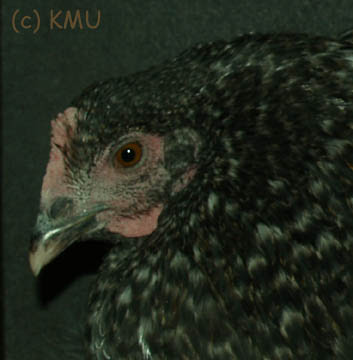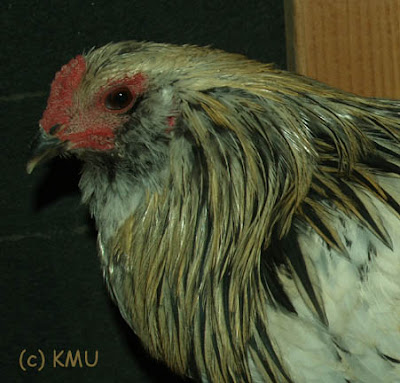 Well, I think the Princess Chicken turned out to be a rooster after all. It is growing spurs and also does still occasionally crow. The feathers on its neck look more traditionally male than female. On the other hand, it doesn't strut around like the other 3 roosters. In fact, it acts decidedly hen-like, even though its tail has elongated to rooster proportions and it has other "roostery" attributes. Nice example of a classic "rose" comb here - but also note absence of wattles. Could it still be a hen - just a hen with extra testosterone? If it is a rooster, it isn't even really number 4 of 4 - the other 3 roosters don't even treat it like it's a rooster. My friend says that maybe "he" is a San Francisco Princess. In any event, the Prince/Princess is healthy and happy.
Well, I think the Princess Chicken turned out to be a rooster after all. It is growing spurs and also does still occasionally crow. The feathers on its neck look more traditionally male than female. On the other hand, it doesn't strut around like the other 3 roosters. In fact, it acts decidedly hen-like, even though its tail has elongated to rooster proportions and it has other "roostery" attributes. Nice example of a classic "rose" comb here - but also note absence of wattles. Could it still be a hen - just a hen with extra testosterone? If it is a rooster, it isn't even really number 4 of 4 - the other 3 roosters don't even treat it like it's a rooster. My friend says that maybe "he" is a San Francisco Princess. In any event, the Prince/Princess is healthy and happy. Silver Laced Wyandotte Pullet (Hen) - she is puffed out and settled down for the night. Note the small "rose" comb and dark beak. Generally speaking, these are the first ones to come running when I head towards the chicken run with "goodies."
Silver Laced Wyandotte Pullet (Hen) - she is puffed out and settled down for the night. Note the small "rose" comb and dark beak. Generally speaking, these are the first ones to come running when I head towards the chicken run with "goodies." Maran Pullet (Hen) - of the three types of hens in my flock, these are the most aggressive towards other hens. The Top Hen is a Maran and roosts on the ladder, higher up than even the roosters. They don't have true "rose" combs, but have a little "mini-comb." The Maran rooster has a full comb and full wattles. You can see the hen barely has any wattles (the red skin flaps that hang from their cheeks).
Maran Pullet (Hen) - of the three types of hens in my flock, these are the most aggressive towards other hens. The Top Hen is a Maran and roosts on the ladder, higher up than even the roosters. They don't have true "rose" combs, but have a little "mini-comb." The Maran rooster has a full comb and full wattles. You can see the hen barely has any wattles (the red skin flaps that hang from their cheeks). Head Rooster ready for Sleepy Time. He is a Maran rooster and is the "Top Dog" in the chicken coop. Note full comb and wattles. I hope they don't get frost bit this winter.
Head Rooster ready for Sleepy Time. He is a Maran rooster and is the "Top Dog" in the chicken coop. Note full comb and wattles. I hope they don't get frost bit this winter. "Easter Egger (EEs)" rooster. The EEs were sold as "Ameracaunas," but I am not sure that they are truly such. In any event, this is my prettiest rooster. In fact, he is the prettiest chicken in the whole flock. I am hoping to breed him to the white EEs in the summer. He is 3rd out of four on the hierarchy ladder.
"Easter Egger (EEs)" rooster. The EEs were sold as "Ameracaunas," but I am not sure that they are truly such. In any event, this is my prettiest rooster. In fact, he is the prettiest chicken in the whole flock. I am hoping to breed him to the white EEs in the summer. He is 3rd out of four on the hierarchy ladder. Speaking of ladders, here is a Silver Laced Wyandotte peaking out from her nightly roost on the ladder.
Speaking of ladders, here is a Silver Laced Wyandotte peaking out from her nightly roost on the ladder. An Orange/Brown EE Pullet (Hen) - The brown EEs seem to have an attitude issue. The white EEs don't seem to have this problem. Perhaps they are not related to the Orange/Brown ones. This one tends to come up behind me and pick at the rivets in my jeans or painfully pluck at my wedding ring.
An Orange/Brown EE Pullet (Hen) - The brown EEs seem to have an attitude issue. The white EEs don't seem to have this problem. Perhaps they are not related to the Orange/Brown ones. This one tends to come up behind me and pick at the rivets in my jeans or painfully pluck at my wedding ring. 
White "EE" Pullet. A bit less agressive than their darker cousins.









